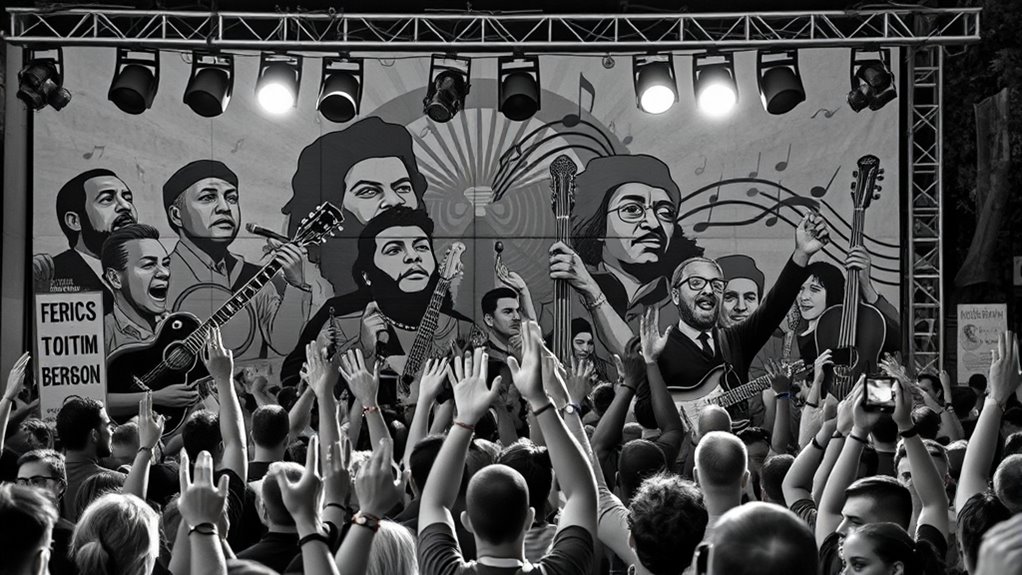Music has long been a powerful tool for sparking revolutions and driving social change. It unites people, boosts morale, and spreads messages of hope or resistance through memorable melodies and lyrics. Protest songs like “We Shall Overcome” or “Fortunate Son” become symbols that rally communities and expose injustices. By inspiring collective action, music shapes movements and leaves a lasting impact. Want to understand how these anthems continue to influence societies today? Keep exploring to learn more.
Key Takeaways
- Protest anthems serve as rallying cries, uniting people and inspiring collective action during social movements.
- Songs like “We Shall Overcome” and “Fortunate Son” symbolize hope and dissent, fueling motivation and resilience.
- Music shapes movement identity, spreading messages and fostering emotional connections that strengthen collective resolve.
- Modern social issues inspire new protest songs, amplified through social media to reach wide audiences and energize activism.
- Music acts as a catalyst for social change by uniting communities, evoking emotion, and sustaining resistance over time.

Have you ever wondered how music can influence society beyond entertainment? It’s a powerful force, capable of inspiring change and uniting people in ways words alone often can’t. Throughout history, protest anthems have served as rallying cries, fueling cultural movements and giving voice to collective frustrations. These songs do more than entertain; they become symbols of resistance, helping marginalized groups find strength and solidarity. When a song resonates with a cause, it transforms into a soundtrack for revolution, motivating individuals to stand up and demand change.
Music as a catalyst for social change unites, empowers, and inspires collective action beyond mere entertainment.
Protest anthems have a unique ability to encapsulate complex emotions and ideas into simple, memorable melodies. Think of them as musical banners fluttering in the wind, rallying crowds and sparking discussions. During civil rights struggles, anthems like “We Shall Overcome” became emblematic of hope and perseverance. Similarly, during anti-war protests, songs like “Fortunate Son” voiced widespread dissent and exposed societal injustices. These anthems transcend language barriers, allowing people from different backgrounds to connect through shared feelings and goals. They serve as rallying cries that reinforce the unity and resolve of those fighting for justice.
Music’s role in cultural movements extends beyond protest songs. It shapes the identity of movements, helping them spread their message and attract new supporters. The rhythm, lyrics, and tone of a song can evoke a sense of urgency or hope, depending on what’s needed at the moment. When a movement adopts a particular song, it’s more than just music; it becomes a symbol of collective identity. Think of the 1960s counterculture, where folk and rock music defined a generation’s desire for peace and change. These sounds created a shared experience, making the movement’s ideals more tangible and emotionally powerful. Additionally, the active engagement promoted through dynamic communication exercises can amplify the impact of these musical symbols by fostering a stronger sense of community and shared purpose.
Moreover, music’s influence persists because it can adapt and evolve along with social struggles. New protest anthems continue to emerge, inspired by contemporary issues like climate change, racial injustice, and political corruption. Artists today harness social media to amplify their messages, making songs go viral and reach global audiences instantly. This ongoing musical dialogue keeps social movements alive and relevant, inspiring new generations to stand up and challenge the status quo. Through protest anthems and cultural movements, music remains a crucial tool for social change—an enduring soundtrack that motivates action and keeps the spirit of resistance alive.
Frequently Asked Questions
How Did Protest Songs Originate Historically?
You see, protest songs originated as a powerful form of cultural expression and political commentary. People used music to voice their discontent, rally support, and challenge authority throughout history. These songs often emerged during social movements, conveying messages of resistance and hope. By blending melody with meaningful lyrics, protest songs became a tool for mobilization and change, shaping the way societies responded to injustice.
Which Genres Are Most Associated With Revolutionary Movements?
Did you know that folk and protest music are most associated with revolutionary movements? These genres powerfully express cultural identity and use musical symbolism to unite people. You can feel their impact in chants and melodies that inspire change. When you listen to these genres, you see how sound becomes a tool for social justice, transforming personal stories into collective voices that challenge the status quo and spark revolutions.
How Does Music Influence Youth Activism Today?
You see how music influences youth activism today through musical empowerment, inspiring you to stand up and speak out. Digital activism amplifies this impact, allowing you to share powerful songs and messages instantly across social media. Music becomes a tool for connection, motivation, and raising awareness, helping you unite with others to challenge injustices. It’s a dynamic force that energizes your activism and fuels social change in the digital age.
Can Music Alone Sustain Long-Term Social Movements?
You might wonder if music alone can sustain long-term social movements. While music acts as social glue and strengthens cultural identity through song, it can’t carry a movement by itself. It unites people emotionally and reinforces shared values, but sustained change needs organized efforts, policy changes, and persistent activism. Music fuels motivation and solidarity, yet lasting social movements require more than sound; they need ongoing commitment and tangible actions.
What Role Do Underground or Illegal Music Scenes Play in Revolutions?
You might think underground networks and illegal concerts are mere rebels’ playgrounds, but they’re actually essential to revolutions. These clandestine scenes ignite passion, foster unity, and spread dissent beyond official channels. Through secret shows and hidden venues, you create a resilient underground culture that challenges authority and inspires change. Ironically, it’s in these illegal spaces that the true power of music as a catalyst for social upheaval thrives, fueling revolutionary sparks.
Conclusion
As you listen to the melodies that once fueled revolutions, you realize that music’s power isn’t just in its notes, but in its ability to ignite change. It’s a force that can inspire millions, challenge the status quo, and whisper promises of a better tomorrow. So, next time you hear that song, ask yourself: could it be the beginning of the next wave of social upheaval? The future’s rhythm is waiting to be written.









